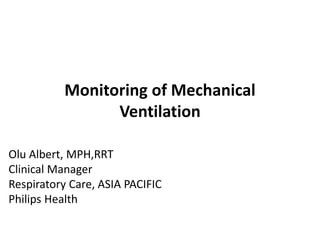
Monitoring of Mechanical Ventilation by OluAlbert
- 1. Monitoring of Mechanical Ventilation Olu Albert, MPH,RRT Clinical Manager Respiratory Care, ASIA PACIFIC Philips Health
- 2. Monitoring of Mechanical Ventilation • Pressure, Flow, and Volume in ventilator circuit • Calculated “Monitored” Parameters – Compliance – Resistance – MAP – Time Constants • Waveform Analysis (Measured Parameters) – Pressure – Flow – Volume • Loops – Pressure volume – Flow volume
- 5. PEEP PIP Pplat Raw= Pta /V compliance tidal volume end-inspiratory alveolar pressure Pta = PIP - Pplat
- 7. Monitoring Compliance and Airway Resistance
- 8. normal 100 mL/cm H2O Cst = Pplat - PEEP Tidal Volume Compliance • Mainstem Intubation • Congestive Heart Failure • ARDS • Atelectasis • Consolidation • Fibrosis • Hyperinflation • Tension Pneumothorax • Pleural Effusion • Abdominal Distension • Chest Wall Edema • Thoracic Deformity Decreased with: Correct for gas compression Total PEEP
- 9. Increased with: Raw = PIP - Pplat flow Airway Resistance (Raw) • Secretions • Bronchospasm • Small endotracheal tube • Mucosal edema Normal: 5 - 10 cm H2O/L/s for intubated ventilated adults measure with 60 L/min (1 L/s) constant flow
- 10. Calculation of Cs & Raw A patient is volume ventilated at the following settings: PIP = 24 cmH20, Pplt = 17 cmH20, and VT = 400 ml, PEEP = 5 cmH20. What is Pta? What is the Cst? Flow was 35 L/min. What is the Raw? Is the Raw normal?
- 11. • Pta = PIP – Pplt = 24-17 = 7 cmH20 • Cst = VT /Pplt-PEEP =400 ml/(17- 5cmH20)= 33.3mL/cmH20 • Raw = Pta/Flow Flow = 35 L/min, 35 L/60 sec = 0.58 L/s Raw = 7 cmH20/0.58 L/s = 12 cmH20/L/sec
- 12. Pplat 30 cm H2O Transpulmonary Pressure = 15 cm H2O Pplat = Palv; Pplat = Transpulmonary Pressure? +15 cm H2O Stiff chest wall
- 13. PCV 20 cm H2O, PEEP 10 cm H2O =Pplat 30 cm H2O -15 cm H2O Transpulmonary Pressure = 45 cm H2O Active inspiratory effort Pplat = Palv; Pplat = Transpulmonary Pressure?
- 14. Pplat 30 cm H2O, VCV Pplat 30 cm H2O, PCV Active inspiratory effort Pplat 30 cm H2O, VCV Pplat = Palv; Pplat = Transpulmonary Pressure? Risk of VILI may be different with the same Pplat
- 16. Mean Airway Pressure (MAP) • MAP is affected by PIP, PEEP, Total Cycle Time (TCT) and RR • MAP = ½ (PIP-PEEP) x (Ti/TCT) + PEEP • MAP is useful to monitor to assess the benefits and side effects of Positive Pressure Ventilation (= Mean Alveolar Pressure)
- 17. Time Constants
- 18. Time Constants • Is the length of time lung units require to fill & empty • T = Raw X Cst where: T = Time Constants Raw = Airway Resistance Cst = Static Compliance
- 19. Clinical Applications: Time Constant • “Fast” alveoli = short time constant (fast filling) --Pulmonary fibrosis (low Cst & low Raw) • “Slow” alveoli = long time constant (slow filling) --Asthma (high Cst & high Raw)
- 22. Pressure-Controlled Ventilation Lucangelo, Respir Care 2005; 50:55
- 23. Pressure-Controlled Ventilation Increasing airways resistance Decreasing lung compliance Lucangelo, Respir Care 2005; 50:55
- 24. WK505 Effort Nilsestuen, Respir Care 2005; 50:202-232 Volume-Controlled Ventilation
- 26. set PEEP auto PEEP pressure time PIP PIP No active exhalation or inspiratory effort Treats lungs as single compartment
- 27. Dhand, Respir Care 2005; 50:251
- 28. Problems with Auto-PEEP • Increased Pplat and over-distention – Increase work-of-breathing – Hemodynamic effects – Pneumothorax • Difficulty triggering ventilator
- 29. sensitivity -1 cm H2O auto-PEEP 10 cm H2O trigger effort = 11 cm H2O sensitivity -1 cm H2O auto-PEEP 3 cm H2O trigger effort = 4 cm H2O PEEP 7 cm H2O PEEP 10 cm H2O PEEP 10 cm H2O Auto-PEEP should be measured with set PEEP = 0
- 30. Ways to reduce Auto-PEEP: • Increasing inspiratory flow • Reduce minute ventilation (Ve) • Suctioning the patient • Changing the modes to allow for more spontaneous breaths
- 31. In VCV, use the following to evaluate the graphics: • What is the flow pattern? • What is the PEFR • Is auto-PEEP present? • Is a leak present? • What is PIP? • Is flow to the patient adequate? • Has the sensitivity been set appropriately?
- 33. 0 10 20 30 40 00.40.81.21.6 normal ARDS airway pressure (cm H2O) volumeaboveFRC(liters) lower inflection point upper inflection point
- 35. Flow-Volume Loop
- 36. Dhand, Respir Care 2005; 50:256
- 37. Dhand, Respir Care 2005; 50:246
- 38. Key Points: • Monitoring of mechanically ventilated patients is dependent on the assessment of lung mechanics • Evaluation of Compliance, Resistance and PV curves/loops can help us determine the baseline condition of lung mechanics